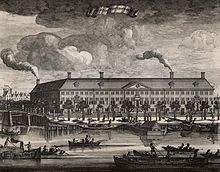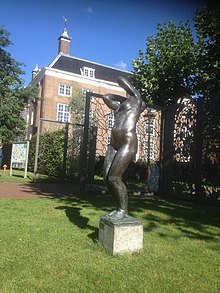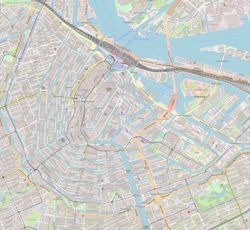H'ART Museum: Difference between revisions
Dicesoapdice (talk | contribs) No edit summary |
Highpeaks35 (talk | contribs) tweak |
||
| Line 3: | Line 3: | ||
| image = Hermitage Amsterdam - Ingang.JPG |
| image = Hermitage Amsterdam - Ingang.JPG |
||
| image_upright = 1.15 |
| image_upright = 1.15 |
||
| caption = Entrance of the |
| caption = Entrance of the Hermitage Amsterdam. |
||
| alt = The entrance of the Hermitage Amsterdam |
| alt = The entrance of the Hermitage Amsterdam |
||
| map_type = Netherlands Amsterdam Central |
| map_type = Netherlands Amsterdam Central |
||
| Line 31: | Line 31: | ||
==History== |
==History== |
||
[[File:Amstelhofo.jpg|thumb|A 1693 etching of the [[Amstelhof]], showing the building out of proportions]] |
[[File:Amstelhofo.jpg|thumb|A 1693 etching of the [[Amstelhof]], showing the building out of proportions.]] |
||
The structure opened in 1682 as a [[retirement home]] for elderly women under the name Diaconie Oude Vrouwen Huys ({{lang-en|Deanery Home for Old Women}}) on the east bank of the river [[Amstel]]. Beginning in 1817, the facility housed both elderly men and women, and was renamed Diaconie Oude Vrouwen- en [[Oude Mannenhuis|Mannenhuis]] (English: Deanery Home for Old Men and Women). The building was first named [[Amstelhof]] ({{lang-en|Amstel Court}}) in 1953.<ref name="building">{{cite web| title=History of the Building| url=http://www.hermitage.nl/en/hermitage_amsterdam/geschiedenis_van_het_gebouw.htm| publisher=Hermitage Amsterdam| accessdate=2012-01-07}}</ref> |
The structure opened in 1682 as a [[retirement home]] for elderly women under the name Diaconie Oude Vrouwen Huys ({{lang-en|Deanery Home for Old Women}}) on the east bank of the river [[Amstel]]. Beginning in 1817, the facility housed both elderly men and women, and was renamed Diaconie Oude Vrouwen- en [[Oude Mannenhuis|Mannenhuis]] (English: Deanery Home for Old Men and Women). The building was first named [[Amstelhof]] ({{lang-en|Amstel Court}}) in 1953.<ref name="building">{{cite web| title=History of the Building| url=http://www.hermitage.nl/en/hermitage_amsterdam/geschiedenis_van_het_gebouw.htm| publisher=Hermitage Amsterdam| accessdate=2012-01-07}}</ref> |
||
| Line 42: | Line 42: | ||
==Exhibitions== |
==Exhibitions== |
||
[[File:Dmitry Medvedev in the Netherlands 20 June 2009-5.jpg|thumb|[[Russian President]] [[Dmitry Medvedev]] and [[Beatrix of the Netherlands|Queen Beatrix]] at the official opening of Hermitage Amsterdam on 20 June 2009]] |
[[File:Dmitry Medvedev in the Netherlands 20 June 2009-5.jpg|thumb|[[Russian President]] [[Dmitry Medvedev]] and [[Beatrix of the Netherlands|Queen Beatrix]] at the official opening of Hermitage Amsterdam on 20 June 2009.]] |
||
The museum houses two permanent presentations, one describes [[Netherlands–Russia relations]] and the other details the history of the [[Amstelhof]] building.<ref name="permanent">{{cite web| title=Permanent Presentations at the Hermitage Amsterdam| url=http://www.hermitage.nl/en/pers/algemeen/persberichten/informatie_vaste_presentaties.htm| publisher=Hermitage Amsterdam| accessdate=2012-01-07}}</ref> Temporary exhibitions usually are scheduled for six-months.<ref name="opening"/> |
The museum houses two permanent presentations, one describes [[Netherlands–Russia relations]] and the other details the history of the [[Amstelhof]] building.<ref name="permanent">{{cite web| title=Permanent Presentations at the Hermitage Amsterdam| url=http://www.hermitage.nl/en/pers/algemeen/persberichten/informatie_vaste_presentaties.htm| publisher=Hermitage Amsterdam| accessdate=2012-01-07}}</ref> Temporary exhibitions usually are scheduled for six-months.<ref name="opening"/> |
||
| Line 53: | Line 53: | ||
===Matisse to Malevich=== |
===Matisse to Malevich=== |
||
[[File:Katja(1983)eRmitAdam.jpg|thumb|Statue of a nude woman called 'Katja' created in 1983 by sculptor [[:d:Q2186653|Eddy Roos]] in the garden of Hermitage Amsterdam |
[[File:Katja(1983)eRmitAdam.jpg|thumb|Statue of a nude woman called 'Katja' created in 1983 by sculptor [[:d:Q2186653|Eddy Roos]] in the garden of Hermitage Amsterdam.]] |
||
* ''Matisse to Malevich. Pioneers of Modern Art from the Hermitage'' 6 March to 17 September 2010 |
* ''Matisse to Malevich. Pioneers of Modern Art from the Hermitage'' 6 March to 17 September 2010 |
||
The exhibit was the first display in The Netherlands of works from the Hermitage Museum's collections of French paintings of the late 19th and early 20th century. The collection was started by Russian collectors Morozov and [[Sergei Shchukin|Shchukin]]. The exhibit contained hundreds of masterpieces by artists who pioneered [[Modernism]], including [[Henri Matisse|Matisse]], [[Kees van Dongen|Van Dongen]], De Vlaminck, [[André Derain|Derain]] and [[Pablo Picasso|Picasso]]. It looked at the concept of Modernism from a historical perspective and examined how artists joined the new movement. The guest curator for the exhibit was Henk van Os, Professor at the University of Amsterdam and chairman of the Specialists Council of the Hermitage Amsterdam. |
The exhibit was the first display in The Netherlands of works from the Hermitage Museum's collections of French paintings of the late 19th and early 20th century. The collection was started by Russian collectors Morozov and [[Sergei Shchukin|Shchukin]]. The exhibit contained hundreds of masterpieces by artists who pioneered [[Modernism]], including [[Henri Matisse|Matisse]], [[Kees van Dongen|Van Dongen]], De Vlaminck, [[André Derain|Derain]] and [[Pablo Picasso|Picasso]]. It looked at the concept of Modernism from a historical perspective and examined how artists joined the new movement. The guest curator for the exhibit was Henk van Os, Professor at the University of Amsterdam and chairman of the Specialists Council of the Hermitage Amsterdam. |
||
Revision as of 03:52, 4 February 2019
 Entrance of the Hermitage Amsterdam. | |
| Established | 1682 (building)[1] 2004 (museum)[2] |
|---|---|
| Location | Amstel 51 Amsterdam, Netherlands |
| Coordinates | 52°21′54″N 4°54′09″E / 52.365°N 4.9025°E |
| Type | Art museum |
| Visitors | 380,931 (2013)[3]
|
| Director | Cathelijne Broers[4] |
| Public transit access | Waterlooplein[5] Metro: 51 Tram: 9 |
| Website | www |
Hermitage Amsterdam is a branch museum of the Hermitage Museum of Saint Petersburg, Russia, located on the banks of the Amstel river in Amsterdam. The museum is located in the former Amstelhof, a classical style building from 1681. The dependency displayed small exhibitions in the adjacent Neerlandia Building from 24 February 2004 until the main museum opened on 19 June 2009.
It is currently the largest satellite of the Hermitage Museum, with a total area of 12,846 m2 (138,270 sq ft)[6] and fits with the museum's plan to make its collections accessible to more people.[7] The exhibition area covers 2,172 m2 (23,380 sq ft) and is contained within two large exhibition halls and smaller exhibition rooms. The remaining space holds lecture halls, offices and staff accommodations and a restaurant.[8]
History

The structure opened in 1682 as a retirement home for elderly women under the name Diaconie Oude Vrouwen Huys (Template:Lang-en) on the east bank of the river Amstel. Beginning in 1817, the facility housed both elderly men and women, and was renamed Diaconie Oude Vrouwen- en Mannenhuis (English: Deanery Home for Old Men and Women). The building was first named Amstelhof (Template:Lang-en) in 1953.[9]
In the 1990s, operators of the facility determined that it was inadequate to meet the modern needs of its residents and sought to build a new structure elsewhere. They offered the historic structure to the city of Amsterdam, who, in turn, leased it to the museum. The last inhabitants left the Amstelhof in 2007.[10] On 20 June 2009, the museum was opened by Dutch Queen Beatrix and Russian President Dmitry Medvedev. The museum was open to the public the following day.[11][12]
During the more than 300 years that residents were housed in the Amstelhof, several renovations took place on the building interior and wings were added to provide needed space. Thus, little of the original interior remained when work for the museum began. While some areas were restored to their original appearance, many existing walls were removed and spaces reconfigured to accommodate the museum's needs. The total cost of the renovations was €40 million.[13]
The temporary museum in the Neerlandia Building on the Nieuwe Keizersgracht closed in 2008 to become the Hermitage for Children. It opened along with the main museum on 20 June 2009.
Exhibitions

The museum houses two permanent presentations, one describes Netherlands–Russia relations and the other details the history of the Amstelhof building.[14] Temporary exhibitions usually are scheduled for six-months.[6]
The immortal Alexander the Great
- The Immortal Alexander the Great The Myth, The Truth, His Journey, His Legacy, 18 September 2010 – 18 March 2011.
Alexander the Great (356 BC – 323 BC, king from 336 BC) appeals to the imagination more than any ruler of the ancient age. Beginning in his youth he inspired those around him. During his campaigns in the East, Alexander searched for the origins of Dionysus, whom the ancient Greeks believed came from the exotic East, possibly India. He followed in the footsteps of Dionysus to reach countries such as Bactria, Egypt, India, Mongolia, Persia and Syria. Everywhere he went he established cities, naming many Alexandria, and left behind a legacy of Greek culture in the form of Hellenism.
Alexander's fame lived long after antiquity as an example to many European, Russian and Islamic rulers. His life and history were depicted through paintings, tapestries and decorative art from classical antiquity to the modern age, of Western and non-Western origins.[15]
Matisse to Malevich

- Matisse to Malevich. Pioneers of Modern Art from the Hermitage 6 March to 17 September 2010
The exhibit was the first display in The Netherlands of works from the Hermitage Museum's collections of French paintings of the late 19th and early 20th century. The collection was started by Russian collectors Morozov and Shchukin. The exhibit contained hundreds of masterpieces by artists who pioneered Modernism, including Matisse, Van Dongen, De Vlaminck, Derain and Picasso. It looked at the concept of Modernism from a historical perspective and examined how artists joined the new movement. The guest curator for the exhibit was Henk van Os, Professor at the University of Amsterdam and chairman of the Specialists Council of the Hermitage Amsterdam.
The museum is planning a sequel exhibition that will examine the origins of this modern art through a display of works by Impressionists from the Hermitage.[16]
References
- ^ History of the Building, Hermitage Amsterdam. Retrieved on 2013-04-14.
- ^ From Amstelhof to Hermitage Amsterdam, Hermitage Amsterdam. Retrieved on 2013-04-14.
- ^ Template:Nl icon Activiteitenverslag 2013, Hermitage Amsterdam. Retrieved on 28 June 2014.
- ^ Cathelijne Broers takes over as director of De Nieuwe Kerk and the Hermitage Amsterdam, Hermitage Amsterdam, 2011. Retrieved on 2013-04-14.
- ^ a b c Visit, Hermitage Amsterdam. Retrieved on 2013-04-14.
- ^ a b "Hermitage to open 20 June 2009". Hermitage Amsterdam. Retrieved 2012-01-07.
- ^ "The formal opening of the Hermitage Amsterdam Centre" (Press release). State Hermitage Museum. 19 June 2009. Archived from the original on 5 January 2013. Retrieved 2013-01-07.
{{cite press release}}: Unknown parameter|deadurl=ignored (|url-status=suggested) (help) - ^ "The Hermitage Amsterdam Centre: History of the Project". State Hermitage Museum. Archived from the original on 2013-01-05. Retrieved 2013-01-07.
{{cite web}}: Unknown parameter|deadurl=ignored (|url-status=suggested) (help) - ^ "History of the Building". Hermitage Amsterdam. Retrieved 2012-01-07.
- ^ "From Amstelhof to Hermitage Amsterdam". Hermitage Amsterdam. Retrieved 2012-01-07.
- ^ Kreijger, Gilbert (18 June 2009). "Russia's Hermitage museum opens Amsterdam branch". Reuters.com. Retrieved 2012-01-07.
- ^ "Hermitage Amsterdam opened". NRC Handelsblad. nrc.nl. 19 June 2009. Retrieved 2012-01-07.
- ^ "Background Hermitage Amsterdam". Hermitage Amsterdam. Retrieved 2012-01-07.
- ^ "Permanent Presentations at the Hermitage Amsterdam". Hermitage Amsterdam. Retrieved 2012-01-07.
- ^ "The Imortal Alexander the Great" (Press release). Hermitage Amsterdam. 18 September 2008. Retrieved 2013-01-07.
- ^ "Matisse to Malevich: Pioneers of Modern Art from the Hermitage" (Press release). Hermitage Amsterdam. 6 March 2010. Retrieved 2013-01-07.

